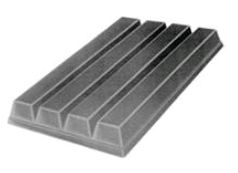Nestlé filed an application with the UK-IPO to register the three dimensional trade mark shown below for Chocolate; chocolate confectionery; chocolate products; confectionery; chocolate-based preparations; bakery goods; pastries; biscuits; biscuits having a chocolate coating; chocolate coated wafer biscuits; cakes; cookies; wafers in Class 30.

The application was accepted and published by the UK- IPO on the basis that Nestlé had shown the mark to have acquired a distinctive character as a result of use. Nestlé had already obtained a CTM registration for the same shape and was able to successfully defend a cancellation action filed by Cadbury UK Limited ("Cadbury") last year when the OHIM Board of Appeal held that the shape did not perform a technical function.
The UK application was opposed by Cadbury on the basis that the mark lacked distinctive character being a shape that was customary in the established practices of the chocolate bar and biscuit trade and being one which is exclusively necessary to obtain a technical result, namely the division of the chocolate into fingers.
After considering the technical functionality objection at length, the hearing officer concluded that the shape was attributable only to a technical result and minor arbitrary features had no real impact and did not overcome that fact. Consequently the mark was prohibited from registration under s3(2)(b) of the UK's Trade Marks Act 1994 ("Act") which bars registration of shapes necessary to obtain a technical result. The slab shape was found to result from the nature of moulded chocolate bars or moulded chocolate biscuits sold in bar form and the presence of the grooves was a feature necessary to achieve the technical result of breaking the bar into "fingers".
The UK-IPO went on to consider whether the shape was distinctive or had acquired distinctiveness through use overcoming the prohibition under s3(1)(b) of the Act which prohibits registration of trade marks devoid of distinctive character. Reviewing the purpose of a trade mark, namely "to permit consumers to make informed choices between the competing goods of differing undertakings in the course of trade" it was found that Nestlé had failed to show that consumers rely on the shape of the chocolate bar to identify the origin of the goods. As other products consisting of essentially a number of joined chocolate fingers have been present on the UK market for a long time, the shape was held to be within the norms and customs of the chocolate and biscuit trade sector with the result that it would not permit the average consumer to distinguish the product from those of other undertakings.
Turning to acquired distinctiveness, while Nestlé was found to be able demonstrate that a significant proportion of the public recognises the shape as that of their KIT KAT chocolate bar, this was held to be insufficient for the test of acquired distinctiveness. It must also be shown that those consumers rely upon the shape to identify the origin of the goods which was not demonstrated. In this case, the chocolate bar is sold in an opaque wrapper and no evidence showed that the shape of the product featured in promotions for the chocolate bar for many years prior to the date of application. Therefore, consumers are unlikely to rely on the shape to identify the goods at the selection process and protection as a trade mark would be unjustified as the shape would not serve as an indicator of trade origin.
It is likely that Nestlé will appeal this decision particularly due to its success in maintaining an EU-wide registration for the same shape of bar. In commenting on their ability to successfully overcome the cancellation action against their CTM registration, the UK-IPO noted that the CTM registration was not obtained for chocolate, chocolate products, chocolate confectionary or wafers (although it was registered for biscuits) and that it may have been that the Board of Appeal did not have the expert evidence filed in the UK proceedings or the benefit of hearing cross examination of experts on the evidence about the functionally of the shape.
The content of this article is intended to provide a general guide to the subject matter. Specialist advice should be sought about your specific circumstances.



